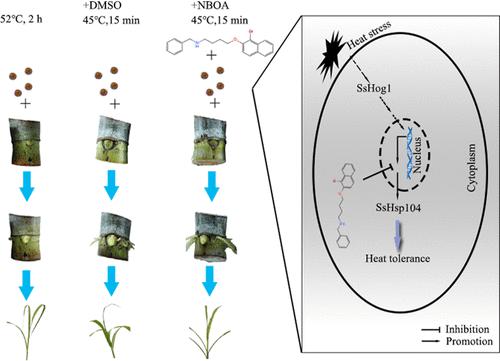当前位置:
X-MOL 学术
›
J. Agric. Food Chem.
›
论文详情
Our official English website, www.x-mol.net, welcomes your
feedback! (Note: you will need to create a separate account there.)
Discovery of N-Benzyl-4-(1-bromonaphthalen-2-yl)oxybutan-1-amine as a Potential Antifungal Agent against Sporidia Growth and Teliospore Germination of Sporisorium scitamineum
Journal of Agricultural and Food Chemistry ( IF 5.7 ) Pub Date : 2024-02-08 , DOI: 10.1021/acs.jafc.3c04589 Enping Cai 1, 2 , Rong Zeng 1, 2 , Ruqing Feng 1, 2 , Li Zhang 1, 2 , Lei Li 1, 2 , Huan Jia 1, 2 , Wenqiang Zheng 1, 2 , Shaofang Chen 1, 2 , Meixin Yan 3 , Changqing Chang 1, 2
Journal of Agricultural and Food Chemistry ( IF 5.7 ) Pub Date : 2024-02-08 , DOI: 10.1021/acs.jafc.3c04589 Enping Cai 1, 2 , Rong Zeng 1, 2 , Ruqing Feng 1, 2 , Li Zhang 1, 2 , Lei Li 1, 2 , Huan Jia 1, 2 , Wenqiang Zheng 1, 2 , Shaofang Chen 1, 2 , Meixin Yan 3 , Changqing Chang 1, 2
Affiliation

|
The cultivation of sugar cane using perennial roots is the primary planting method, which is one of the reasons for the serious occurrence of sugar cane smut disease caused by the basidiomycetous fungus Sporisorium scitamineum in the sugar cane perennial root planting area. Consequently, it is crucial to eliminate pathogens from perennial sugar cane buds. In this study, we found that MAP kinase Hog1 is necessary for heat stress resistance. Subsequent investigations revealed a significant reduction in the expression of the heat shock protein 104-encoding gene, SsHSP104, in the ss1hog1Δ mutant. Additionally, the overexpression of SsHSP104 partially restored colony growth in the ss1hog1Δ strain following heat stress treatment, demonstrating the crucial role of SsHsp104 in SsHog1-mediated heat stress tolerance. Hence, we constructed the ss1hsp104:eGFP fusion strain in the wild type of S. scitamineum to identify small-molecule compounds that could inhibit the heat stress response, leading to the discovery of N-benzyl-4-(1-bromonaphthalen-2-yl)oxybutan-1-amine as a potential compound that targets the SsHog1 mediation SsHsp104 pathway during heat treatment. Furthermore, the combination of N-benzyl-4-(1-bromonaphthalen-2-yl)oxybutan-1-amine and warm water treatment (45 °C for 15 min) inhibits the growth of S. scitamineum and teliospore germination, thereby reducing the occurrence of sugar cane smut diseases and indicating its potential for eliminating pathogens from perennial sugar cane buds. In conclusion, these findings suggest that N-benzyl-4-(1-bromonaphthalen-2-yl)oxybutan-1-amine is promising as a targeted compound for the SsHog1-mediated SsHsp104 pathway and may enable the reduction of hot water treatment duration and/or temperature, thereby limiting the occurrence of sugar cane smut diseases caused by S. scitamineum.
中文翻译:

发现 N-苄基-4-(1-溴萘-2-基)氧基丁-1-胺作为一种潜在的抗真菌剂,可抑制 Scitamineum 孢子虫的生长和冬孢子萌发
利用宿根栽培甘蔗是主要的种植方式,这是甘蔗宿根种植区由担子菌Sporisorium scitamineum引起的甘蔗黑穗病严重发生的原因之一。因此,消除多年生甘蔗芽中的病原体至关重要。在这项研究中,我们发现 MAP 激酶 Hog1 对于抗热应激是必需的。随后的研究表明,在ss1hog1 Δ 突变体中,热休克蛋白 104 编码基因SsHSP104的表达显着降低。此外, SsHSP104的过表达部分恢复了热应激处理后ss1hog1 Δ菌株中的集落生长,这证明了SsHsp104在SsHog1介导的热应激耐受性中的关键作用。因此,我们在野生型S. scitamineum中构建了s s1hsp104:eGFP融合菌株,以鉴定可以抑制热应激反应的小分子化合物,从而发现了N -benzyl-4-(1-bromonaphahen-2) -yl)oxybutan-1-amine 作为一种潜在化合物,在热处理过程中靶向 SsHog1 介导 SsHsp104 途径。此外, N -benzyl-4-(1-溴萘-2-基)oxybutan-1-amine和温水处理(45℃,15分钟)的组合抑制了S. scitamineum的生长和冬孢子萌发,从而减少了甘蔗黑穗病的发生并表明其消除多年生甘蔗芽中病原体的潜力。 总之,这些研究结果表明, N -benzyl-4-(1-bromonathalen-2-yl)oxybutan-1-amine 有希望作为 SsHog1 介导的 SsHsp104 途径的靶向化合物,并可能缩短热水处理时间和/或温度,从而限制由S. scitamineum引起的甘蔗黑穗病的发生。
更新日期:2024-02-08
中文翻译:

发现 N-苄基-4-(1-溴萘-2-基)氧基丁-1-胺作为一种潜在的抗真菌剂,可抑制 Scitamineum 孢子虫的生长和冬孢子萌发
利用宿根栽培甘蔗是主要的种植方式,这是甘蔗宿根种植区由担子菌Sporisorium scitamineum引起的甘蔗黑穗病严重发生的原因之一。因此,消除多年生甘蔗芽中的病原体至关重要。在这项研究中,我们发现 MAP 激酶 Hog1 对于抗热应激是必需的。随后的研究表明,在ss1hog1 Δ 突变体中,热休克蛋白 104 编码基因SsHSP104的表达显着降低。此外, SsHSP104的过表达部分恢复了热应激处理后ss1hog1 Δ菌株中的集落生长,这证明了SsHsp104在SsHog1介导的热应激耐受性中的关键作用。因此,我们在野生型S. scitamineum中构建了s s1hsp104:eGFP融合菌株,以鉴定可以抑制热应激反应的小分子化合物,从而发现了N -benzyl-4-(1-bromonaphahen-2) -yl)oxybutan-1-amine 作为一种潜在化合物,在热处理过程中靶向 SsHog1 介导 SsHsp104 途径。此外, N -benzyl-4-(1-溴萘-2-基)oxybutan-1-amine和温水处理(45℃,15分钟)的组合抑制了S. scitamineum的生长和冬孢子萌发,从而减少了甘蔗黑穗病的发生并表明其消除多年生甘蔗芽中病原体的潜力。 总之,这些研究结果表明, N -benzyl-4-(1-bromonathalen-2-yl)oxybutan-1-amine 有希望作为 SsHog1 介导的 SsHsp104 途径的靶向化合物,并可能缩短热水处理时间和/或温度,从而限制由S. scitamineum引起的甘蔗黑穗病的发生。






























 京公网安备 11010802027423号
京公网安备 11010802027423号